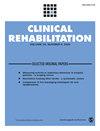线性周期性和非周期性联合训练对肥胖成人身体形象认知的影响:随机临床试验
IF 2.6
3区 医学
Q1 REHABILITATION
引用次数: 0
摘要
目的验证非周期化和线性周期化联合训练对成人肥胖症患者身体形象感知和身体不满意度的影响.设计针对 I 级和 II 级肥胖症患者开展了一项随机临床试验,研究两种类型的联合周期化训练的效果.设置将参与者分为三组:非周期化周期化组、线性周期化组和对照组,每组 23 人.干预措施干预措施持续 16 周(分为三个中间周期,分别为 4 周和 1 周的熟悉期),每周 3 次,每次 1 小时,包括有氧运动(30 分钟)和肌肉力量练习(6 次)。无周期模式组在整个中周期内保持统一的强度、运动量和工作量。结果只有对照组的当前轮廓感增加了(Δ = 1.16;p = 0.04)。随着时间的推移,理想轮廓明显减少(p = 0.001),特别是在非周期性组(Δ = -1.26)。结论无论训练周期如何,联合训练都能有效维持肥胖症成人对当前轮廓的感知,并减少理想轮廓。本文章由计算机程序翻译,如有差异,请以英文原文为准。
Effects of linear periodized and non-periodized combined training on body image perception of adults with obesity: A randomized clinical trial
ObjectiveVerify the effect of non-periodized and linear periodized combined training on body image perception and body dissatisfaction in adults with obesity.DesignA randomized clinical trial on the effect of two types of combined training periodization was carried out on people with grade I and II obesity.SettingParticipants were allocated into three groups: non-periodized periodization group, linear periodization group, and control group, with 23 participants in each.SubjectsAdults with obesity, with a body mass index between 30 kg/m² and 40 kg/m².InterventionsThe intervention lasted 16 weeks (separated into three mesocycles of 4 weeks and 1 week of familiarization), in 3 weekly sessions of 1 hour each, composed of aerobic (30 min) and muscle strength exercises (six exercises) in the same session. The group with non-periodized model maintained uniform intensity, volume, and workload throughout the mesocycles. The group with the linear periodization model started with low initial intensity, subsequently introducing a gradual increase of intensity in the mesocycles.Main measuresBody image perception (current and ideal silhouette) and body dissatisfaction were assessed using the Stunkard silhouette scale.ResultsThe perception of the current silhouette increased only in the control group (Δ = 1.16; p = 0.04). There was a significant reduction in the ideal silhouette over time ( p = 0.001), especially in non-periodized group (Δ = −1.26). Body dissatisfaction increased significantly only over time ( p = 0.001), especially for control group (Δ = 1.47).ConclusionsRegardless of periodization, combined training effectively maintained the perception of the current silhouette and reduced the ideal silhouette in adults with obesity.Trial registrationBrazilian Registry of Clinical Trials (RBR-3c7rt3).
求助全文
通过发布文献求助,成功后即可免费获取论文全文。
去求助
来源期刊

Clinical Rehabilitation
医学-康复医学
CiteScore
5.60
自引率
6.70%
发文量
117
审稿时长
4-8 weeks
期刊介绍:
Clinical Rehabilitation covering the whole field of disability and rehabilitation, this peer-reviewed journal publishes research and discussion articles and acts as a forum for the international dissemination and exchange of information amongst the large number of professionals involved in rehabilitation. This journal is a member of the Committee on Publication Ethics (COPE)
 求助内容:
求助内容: 应助结果提醒方式:
应助结果提醒方式:


